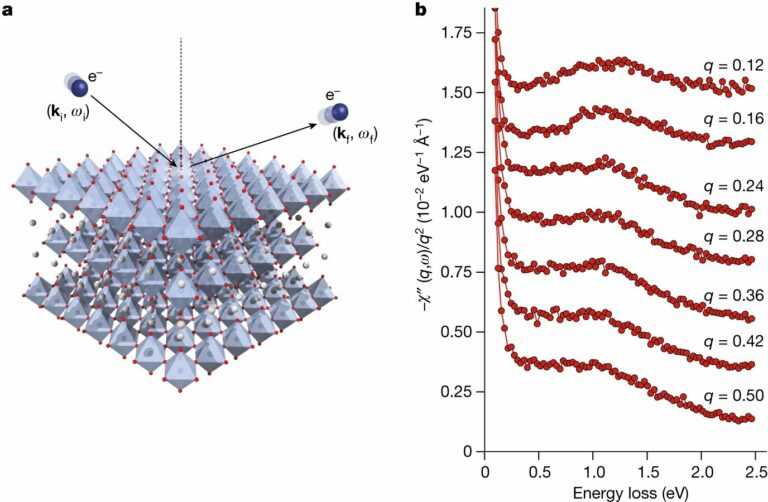The second triangle: the Descending Triangle
Read MorePhysicists found the Demon Particle, so… money?
How Demon Particles can possibly benefit your pockets

On August 9th, 2023, a group of physicists from the University of Illinois published a paper, proving the existence of the demon particle, something that was theorized almost 70 years ago by David Pines, a theoretical physicist. Given our affection for finance and money, in particular, we try to look into how the ‘accidental’ finding can possibly revolutionize the world as we know it.
What is the demon particle?
Despite its cool name, the demon particle is actually short for “distinct electron motion”. It is a quasi-particle — a plasmon — to be exact, which is a combination of electrons in a solid. Flashing back a little, in 1956, David Pines theorized that there exists a type of wave that ripples through plasma electrons — and here’s the cool part: it’s massless and it has a neutral charge. Imagine something without a mass and without a positive or negative charge, there is no doubt looking for it would be quite a task.
As with many wonders of science, the physicists at the University of Illinois somewhat managed to find it, and they did so by accident.
According to Ali Husain, one of the co-authors, they were only trying to analyze a material called strontium ruthenate and see why the material has high-temperature superconductor traits without actually being a superconductor itself. They did so by firing electrons and measuring the energy gain.
Along the way, they detected a kind of particle that doesn’t resemble the others. They tried brushing it off — no way it’s the fabled particle, right? To their luck, it is. The best part about finding the demon particle is that the reason it hasn’t been found is that it is massless, it has no charge, and it doesn’t interact with light. It’s like looking for the invisible man, in a dark room, and you’re blindfolded.
How demon particles can affect the world of physics

As of now, not much is known about it. There are many theories, however, that linger around the properties of this particle. One of the most enticing theories is that demon particles may have a characteristic that facilitates electrons to flow through other particles without any resistance.
In simpler terms, it could be that why superconductors are what they are… is because they contain the demon particles. Electricity can flow without any resistance through them because they have demon particles in them — well, that’s at least as far as the theory goes.
At the very least, even if the demon particle itself is not the superconductor-making material, what it entails is that scientists will now have more access to the studies of superconductivity.
How may it affect finance?

Previously, we have discussed what would happen if the recently famous LK99 material was in fact a room-temperature semiconductor. The issue concerning LK-99, however, is still hanging on the balance, with many purporting it as a false hype. There are also some who support the superconductivity of the material. However, we’ll not dwell on the debate for now — what we’re interested in is the demon particle.
We’ll be clear, it doesn’t bear the big bombastic claims such as those of the LK99, it’s not the holy grail of science. What it is, however, is a clue that can guide us further toward the holy grail of science — a room-temperature superconductor.
In the short term, we are likely to see a race within research institutions, including companies that seek to study the properties of this demon particle. This will mean that more funding will be given to either public or private bodies that seek to study the properties of this demon particle.
The race, however, will be interesting as the goal is to not just study the property of the demon particle, but also to see how it can be applied in real life and — since we’re talking finance — bring us to our pots of gold. It may take a while before they can properly analyze what are the properties of the particles and if the particles can be utilized.
Say, if it is true that demon particles are the cause for superconductivity. The question would then be can we infuse demon particles into other materials? Or can we at least screen for superconductors simply by looking into whether they are inhibited by demon particles?
Even if we can, we will then have to look into the cost of implementing such methods. However, even if it can be costly, there is no doubt that people will try to achieve that, and if it is to be manufactured for usage, it will be used in activities that can afford such spending, such as the particle acceleration process (that is already operating at a massive cost of $1 billion annually).
Like it or not, it will take time before we reach that point, and money will have to keep flowing in. However, if the prospect is high, money shouldn’t be an issue for such a discovery.
What if we can make it? What's going to happen?
If we manage to go to the extent of creating a room-temperature superconductor, it will mean that we are looking at super-efficient electrical flow, and that could possibly be in anything. Your mobile phones, semiconductors, power generators, car batteries, and more.
Apart from efficiency, we are also looking into massive cost reduction. The inefficient electrical flow that we have now leads to energy losses. The heat that you feel when you charge your phone is energy escaping in the form of heat due to resistance in its flow. All of these losses can be slashed if we are to speak in money, power grids in the US lose around $6 billion annually from wastage alone. This will also be in line with our environmental goals.
Even if we don’t get to the point of room-temperature superconductivity, we might be looking at discoveries of higher-temperature superconductors. When speaking of semiconductors, the temperature and pressure around them will play a part in making them superconductive. Often the phrase “high temperature” can be misleading, the highest-temperature superconductor we have for now is lanthanum decahydride, which needs to be in a highly pressurized state, and it will only be superconductive once it reaches -23°C.
Still, the more we can discover the better, even if it’s not a room temperature superconductor, it will still mean that cost can be saved to operate them. As of current, liquid helium is used to cool down superconductors, and as it becomes scarcer, the already high cost is getting even higher.
It would mean a lot to those who rely on superconductors for their affairs such as those that deal with quantum computers, particle accelerators, or even maglev trains, to cut down on the cost of purchasing liquid helium.
All in all, a win is a win, be it big or small.
Bottom line
LK99 might still be on the fence, but when it comes to the demon particle, we have found it. The issue now is only to what extent can we utilize this newly discovered knowledge. As science progresses and discoveries are made, we can’t help but hope for one that could possibly change the world (for the better). What we have with us now is a finding that even if it can’t change the world by itself, it can possibly lead our greatest minds to said path.
The best part is that it could possibly be a good deal on both ends — for the environment and for our pockets. As of now, only time and funding will tell.
The key takeaways/market update is a series by AxeHedge, which serves as an initiative to bring compact and informative In/Visible Talks recaps/takeaways on leading brands and investment events happening around the globe.
Do keep an eye out for our posts by subscribing to our channel and social media.
None of the material above or on our website is to be construed as a solicitation, recommendation or offer to buy or sell any security, financial product or instrument. Investors should carefully consider if the security and/or product is suitable for them in view of their entire investment portfolio. All investing involves risks, including the possible loss of money invested, and past performance does not guarantee future performance.
Trading Dow Pattern the Triangle Pattern (Part 1)
The first triangle: the Ascending Triangle
Read MoreFunds: Equity Funds (Part 3)
How to choose between equity funds based on companies’ earnings...
Read More



